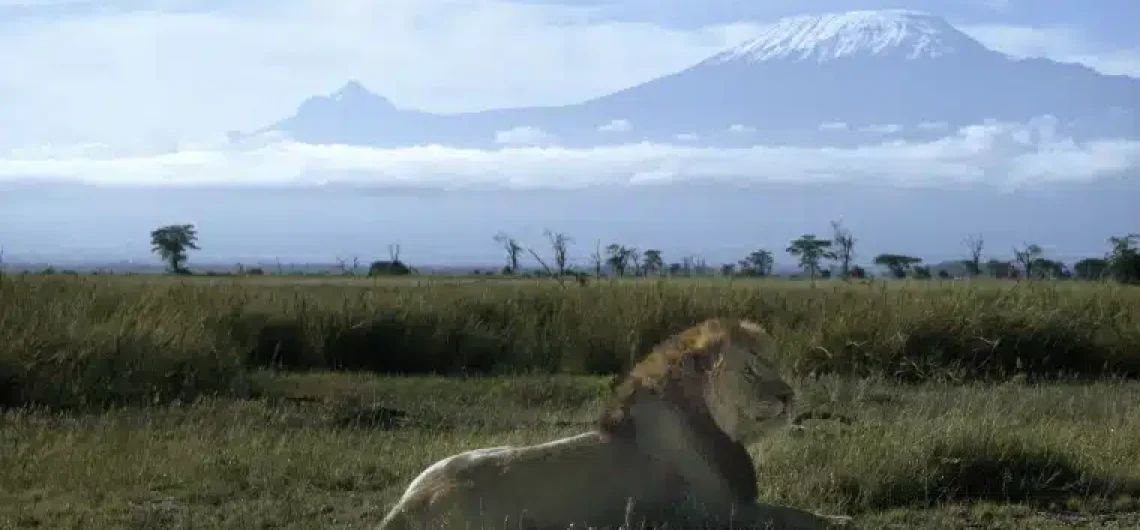No, you will not encounter lions, hyenas, or leopards while climbing Kilimanjaro. The wildlife in the area is not a threat to climbers as the routes are carefully monitored and maintained to ensure safety for all trekkers. Additionally, the park rangers work diligently to keep any potentially dangerous animals away from the popular climbing paths. Kilimanjaro is located in Tanzania, East Africa, and is renowned for its diverse ecosystems and abundant wildlife, but it is not home to large predators like lions, hyenas, or leopards. Instead, climbers may have the opportunity to see various species of birds, monkeys, and small animals along the way. It is important for trekkers to follow safety guidelines and respect the natural habitat of these animals while on the mountain. The trekking routes on Kilimanjaro primarily pass through alpine forests, moorlands, and high-altitude desert, where the wildlife consists mainly of birds, small mammals, and endemic species such as the Kilimanjaro tree hyrax. While there is wildlife present on the mountain, encounters with dangerous predators are extremely rare, and trekkers are more likely to encounter species like monkeys, antelope, and various bird species. However, it’s always essential to follow safety guidelines provided by your guides and trekking companies to ensure a safe and enjoyable climb.
Why there are no lions, leopards, cheetahs and hyenas on Kilimanjaro
There are no lions, leopards, cheetahs, or hyenas on Kilimanjaro primarily because the mountain’s ecosystem does not provide suitable habitat for these large predators. Kilimanjaro is characterized by various ecological zones, including dense forests, moorlands, alpine meadows, and rocky terrain, which are not conducive to supporting populations of large carnivores . Additionally, the high altitude and extreme weather conditions on the mountain make it difficult for these predators to survive and thrive in such an environment. .
Lions, leopards, cheetahs, and hyenas typically inhabit savannahs, grasslands, and woodlands where their prey species, such as antelopes, zebras, and other herbivores, are abundant. Kilimanjaro’s higher elevations lack the prey base necessary to sustain populations of these predators.
Additionally, the harsh climate and extreme conditions found at higher altitudes on Kilimanjaro, including low temperatures, limited vegetation, and oxygen depletion, are not suitable for the survival of large carnivores that require vast territories and abundant prey to thrive.
While Kilimanjaro is home to some wildlife, including birds, small mammals, and endemic species adapted to high-altitude environments, encounters with large predators like lions, leopards, cheetahs, or hyenas are exceedingly rare, if not non-existent, for trekkers ascending the mountain.
Do Lions eat Leopards, Cheetahs, and Hyenas?
Actually, they do not. After killing hyenas, cheetahs, leopards, or African wild dogs (whether they are adults or pups), lions never consume them. This raises the question of why this is the case. To answer your question, the answer is that they will not consume them. Because cheetahs, leopards, hyenas, and African wild dogs aren’t really much of a well-earned meal or a snack that is craved for, a lion won’t gain much from devouring the flesh of another carnivore. In addition, the flesh of these animals isn’t nutritious and doesn’t provide the promise of food, regardless of how hungry the golden cat does become. Because of this, it is willing to kill that carnivore in a ruthless manner and then leave its carcass to rot, comfortable with the knowledge that it has just eliminated another rival for food and territory, as well as another potential danger to its young with its actions. In addition, lions, along with the majority of carnivores, do not consume other carnivores because of a rule known as “The 10 Percent Energy Rule in the food chain.” This rule states that the higher the trophic level, the less energy you receive. As a result, predators like lions obtain more energy by consuming herbivores rather than other carnivores. The breaking of the skin, the removal of the flesh, and the digestion of the meat are all energy-consuming processes, and the meat must be sufficiently nutrient-dense for them to consume. Additionally, it is worth noting that other carnivores have a tendency to have a greater parasite and disease load compared to herbivores (and I would like to thank Rebecca Sealfon for supplying this information). Every animal that is at the top of the food chain is susceptible to contracting diseases from all of the other animals that it consumes. When compared to eating herbivores, which are expected to provide a lower risk of disease in general, the cost of life for eating another predator is significantly higher on the evolutionary scale. If a top predator has a tendency to consume other top predators, they not only put themselves at a greater danger of suffering physical harm, but they also put themselves at risk of developing this sickness. In reality, those who do not consume them have a higher chance of surviving and, as a result, have the opportunity to produce the next generation, passing on their genetics and general disposition to their kids.
![]()


Comments